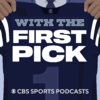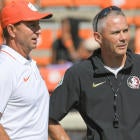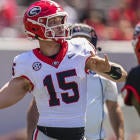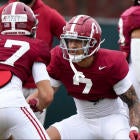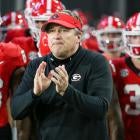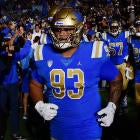Nick Saban paused. He had been asked if compassion ever entered into his hiring philosophy. It is now to the point that a significant foundation of his crimson empire has been built by those on the rebound. You know their names: Kiffin, Sark, Locksley.
There's many others you know and even more you may not. Sure, they were all talented coaches at one point, but they each also had issues before coming to Alabama.
Saban hired them despite those issues, often at times when few others would.
So, in the college football's cold and cutthroat world, did one man's empathy shine through?
Saban chose his words carefully. Perhaps even "The Process" has its limitations.
"We're always looking for a better way," Alabama's coach said. "Those guys, all good coaches, all did a really good job somewhere along the line before. I'm sure they had their own ambitions of what they wanted to accomplish and what they wanted to do here, whether it was to overcome previous failings or learn from people here."
CBS Sports introduces a three-part series that explores Saban's unprecedented success at reviving coaching careers during his 14 years (and counting) at Alabama. That success doesn't seem to be ending anytime soon as Saban recently signed a three-year extension with the Crimson Tide to lead the program through the 2028 season. If he fulfills that contract, he will leave after 22 seasons at age 77.
Five former college head coaches have cycled through Alabama's system over the last eight years, coming out on the other side second chances they were unlikely to have otherwise received. In the case of Steve Sarkisian and Lane Kiffin, it was third chances at being a head coach on this level.
It's part of Saban's coaching tree that extends back to his head coach beginnings at Toledo three decades ago. In January, Sarkisian became the 13th staffer from Saban's Alabama tree alone to become a head coach elsewhere.
"It was perfect," said Kiffin of his three seasons as Alabama offensive coordinator (2014-16). "There wouldn't have been a better job in the NFL. I say [it's] the 'rehab' stamp. You go there, spend some time, all the sudden you can coach again."
Pick your own label, though "Nick Saban's Coaching Rehab" certainly fits.

Most in the coaching profession watch amazed, just like the rest of us. Taking a step down to a lesser position at Alabama has often resulted in a career "car wash". Stains wiped clean. Sins forgiven.
Nick Saban waves his wand, and suddenly, everything is OK.
"Wart removal" is how one former SEC staffer referred to it.
Kiffin was a bit toxic after being fired at USC in 2013. Sarkisian had flamed out spectacularly and publicly with the Trojans only two years later. Certainly, former Alabama offensive coordinator Mike Locksley has benefitted from the wand being waved over him. "Locks" enters his third season at Maryland despite only having won eight games in his six-year head-coaching career.
Bill O'Brien replaces Sark this season as offensive coordinator, possibly becoming the only coach in history to transition from NFL head coach and general manager to college assistant the next season.
Obviously, there's complications and situations to consider. There was a time when O'Brien would have immediately bounced back from his Houston Texans firing to another job in the NFL, likely as an offensive coordinator. College would have been an afterthought.
The same is true for new Alabama offensive line coach Doug Marrone, who joins the staff off a 1-15 season leading the Jacksonville Jaguars. Marrone had spent 16 seasons in the NFL, including eight straight after leaving Syracuse in 2012.
"'The Process' is changeable if there is a better way," said Kevin Steele, Saban's first defensive coordinator at Alabama in 2007.
That's part of the "why" -- why fallen coaches, some of whom could have secured higher-profile, higher-paying jobs, went to T-Town for lesser positions. It's why Saban's brought them all in and why that that issue is hardly a discussion point anymore.
Nick Saban's Coaching Rehab is so real, those who make it to graduation see their careers remade.
"You replace the best play caller in college football [Sarkisian] with a former NFL head coach and general manager," said Craig Young, the father of current Tide quarterback Bryce Young. "Only at Alabama could they do something like that."
Could O'Brien and Marrone still be in the NFL, coaching seasoned professionals and avoiding the added tasks and added hours that come with college coaching, such as recruiting? Absolutely. The league is full of recycled coaches. In that sense, so is Alabama, which might as well be the pros at this point.
"The organization is structured like an NFL team," former Alabama assistant Mike Groh said. "You're coaching a lot of NFL players. You're just coaching them on Saturdays."
Along the way, a mentoring trend was developing that maybe even Saban didn't realize.
"Take the competitive piece out," said former offensive coordinator Jim McElwain (2008-11). "He's really good for a lot of people."
Meet Patient Zero
It's now to the point that just being in Saban's orbit is enough for coaches to trade their egos to live in Tuscaloosa, Alabama. There is a mutual benefit. But it had to start somewhere.
The rehabilitation trend goes back to 2009 when Saban hired Groh as a graduate assistant. Never mind Groh had just been dismissed as his father's offensive coordinator at Virginia. Never mind Groh was becoming a graduate assistant a mere 14 years after getting his undergraduate degree. (Current rules state GAs can be no more than seven years removed from their undergraduate degree.)
Groh qualifies as Patient Zero in this discussion -- the first coach to pass through Nick Saban's Coaching Rehab.
Loosely defined, these are coaches who either come to their positions at Alabama overqualified and underpaid or receive opportunities they simply would not be given elsewhere. Either way, they're absolutely thrilled to get the opportunity.
Groh bounced from that GA spot to Louisville as a quarterbacks coach, returning to Alabama two years later as wide receivers coach and recruiting coordinator. Following his final season with the Tide in 2012, he was named National Recruiter of the Year by 247Sports. Groh then became an established NFL assistant. He's entering his ninth year in the league over five franchises.
"Yeah, I was the first guy," said Groh, now the Indianapolis Colts' WR coach. "It took vision by two people -- me and Coach Saban. At that time, I don't think Coach was thinking about it like this, but then he saw it as a way to get an advantage. He's parlayed that as a way to be able to hire a lot of different kinds of guys since 2009 in that same kind of seat."
Friends in low places
Eleven years ago, Billy Napier had been fired as Dabo Swinney's first offensive coordinator at Clemson. His next move? Becoming an offensive analyst at Alabama in 2011. A low-paid fly on the wall with no coaching or recruiting privileges saw his career change.
"It certainly was probably the most valuable year of my career from a realigning, recentering yourself [standpoint]," he said. "I was 32. I remember telling my wife, Ali, 'If this was our first job in college football, we'd be ecstatic.' It was priceless.
"There was no question it was the right move."
After a couple stops, including four year as Bama WR coach (2013-16), Napier enters his fourth season as Louisiana's head coach. He's now one of the hottest names in the profession who many thought would be coaching a Power Five team this season.
The only common thread to these success stories is Saban himself.
Defensive coordinator Pete Golding is the only member of the 2018 coaching staff still around. In fact, there have been 47 assistant coaches pass through Alabama since Saban took over in 2007, an average of more than three coaching changes per year. The 2018 and 2019 staffs had the most turnover with five new assistants in each season.
Fifth-year Alabama players in 2021 will be experiencing their third offensive coordinator in O'Brien. Of course, those players have already won two national championships.
"I'd love to have continuity because it makes my job a lot easier," Saban said. "One of the hardest things to do is hire people. That's not an easy task. I really try to do a good job of getting good people. At the end of the day, the people make the organization what it is."
The benevolence is there for Saban in resurrecting fallen coaches. You just have to dig.
"I get fired at Clemson [in 2011], the first phone call I got was from Coach Saban," Steele said. "It wasn't from my brother. It wasn't from my mom. It was from Coach Saban. My father passed away in 2008. I get out of the car at the church, and he's walking in the building."
Staying for the first two seasons of Saban's remarkable at Alabama, Steele helped set the table for the 2009 national championship. He returned as a director of player personnel in 2013 and linebackers coach in 2014.
"He's a very, very, very driven man, but he is not a person that takes advantage of people at all," Steele said. "A lot of people that are driven will leave roadkill everywhere. He has done as much for me in times of need that anybody I've worked for."
Sarkisian's disgrace in 2015 looked permanent. At that point, he was as untouchable as any coach in recent years.
Yet, when no one else would take him, Saban did … because of Sark's football mind. Saban correctly surmised that Sark's substance abuse problem could be managed. His football chops were beyond doubt.
In 2020, Steve Sarkisian authored one of the greatest seasons by a college play caller ever.
"I got to know [Saban] beyond the straw hat, beyond the polo on the sidelines, beyond the press conferences," Sarkisian said. "He's an amazing man. He's probably one of the more compassionate human beings I've ever been associated with. That's not something most people describe him as."
Locksley had just spent four years at Maryland trying to revive his career after a disastrous stay at New Mexico (2-26 in three seasons from 2009-11). During his time with the Lobos, Locksley was reprimanded for getting into a physical altercation with an assistant. He was also accused by an administrative assistant of sexual harassment, age discrimination and retaliation. Locksley later resolved "all legal claims" in the matter.
After his car wash, first a rinse as an offensive analyst (2016) then a full soak as coordinator (2017-18), Locksley enters his third year with a 5-12 record at Maryland. Does that happen without Nick Saban's Coaching Rehab?
"It's not normal for minority coaches to get second opportunities or be recycled, especially after not having success," Locksley said. "Because of that … I'm no longer the young guy, the young coach on the staff. I'm on the back nine of my coaching career."
Getting to this point for the 51-year-old Locksley took a radical career turn. After being let go at Maryland as an interim coach following Randy Edsall's firing in 2015, Locksley immediately had offers to become a Power Five coordinator again. Then Debbie Yow called. The former Maryland athletic director -- during Locksley's previous stay from 1997-2002 -- said Alabama was clearly the better option.
Even if it was as an off-field analyst.
"She said, 'I'd take that over being a coordinator at a Power Five right now,'" Locksley recalled. "'It gets you under a different umbrella. If you go there and do a great job, you add Nick Saban to your reference list. [It helps.]' She thought it was important in rebranding myself. It was the best decision I made."
Locksley called the Alabama experience a "sabbatical". That first year as an analyst, he filled "notebook after notebook after notebook on the structure, the why, the how, all those questions that Alabama the place it had become."
In Year 2 at Alabama, Locksley was named co-offensive coordinator with Brian Daboll; the Tide won a national championship. In 2018, Locksley was the offensive coordinator calling plays for Tua Tagovailoa as Bama once again reached the College Football Playoff National Championship.
"Taking that step backward to move forward, not everybody believes in that or believes in the importance of it," Locksley said. "When I took the analyst job, I looked at myself to have a year to put my thoughts together for when I become an offensive coordinator again."
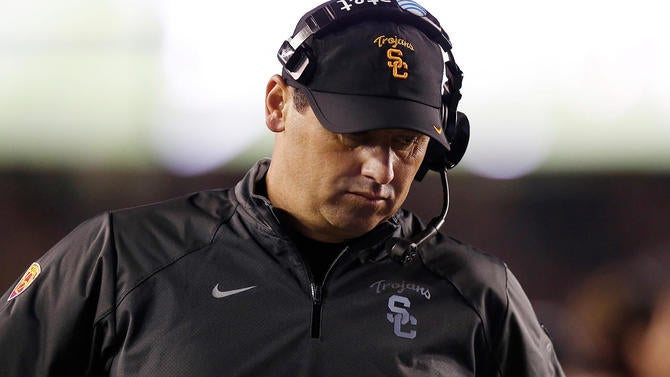
The list is long
Those are the stories most of the public knows about. But there are far more.
- Mike Groh, graduate assistant (2009); WR coach/recruiting coordinator (2011-12): Fired as Virginia offensive coordinator in 2008. Returned after one year as Louisville QB coach. Hired as Chicago Bears WR coach in 2013. Entering his ninth season as an NFL assistant, currently as the Indianapolis Colts WR coach.
- Billy Napier, offensive analyst (2011); WR coach (2013-16): Fired as Dabo Swinney's first offensive coordinator at Clemson in 2010. Returned after one year as Colorado State QB coach. Hired as Arizona State offensive coordinator in 2017 and head coach at Louisiana in 2018.
- Mario Cristobal, OL coach/recruiting coordinator (2013-16): Fired as head coach at FIU in 2012. Hired as Oregon co-offensive coordinator/offensive line coach in 2017. Promoted to replace Willie Taggart as head coach December 2017.
- Lane Kiffin, offensive coordinator (2014-16): Previously fired as head coach of Oakland Raiders in 2008. Left Tennessee after one season in 2009. Fired as USC head coach in 2013. Hired as head coach at FAU in 2017 and Ole Miss in 2020.
- Mike Locksley, offensive analyst (2016); offensive coordinator (2017-18): Previously fired as New Mexico head coach in 2011 for performance and physical altercation with an assistant. Fired as Maryland offensive coordinator in 2015 after Randy Edsall was terminated. Hired as Maryland head coach in 2019.
- Steve Sarkisian, offensive analyst (2016); offensive coordinator (one game in 2016, 2019-20): Fired at USC in 2015 over off-field issues involving alcohol. Hired as offensive analyst in 2016; took over as offensive coordinator for CFP National Championship. Hired as Atlanta Falcons offensive coordinator. Returned when fired after two seasons with Falcons. Hired as Texas head coach in 2021 after winning the Broyles Award for best assistant coach.
- Butch Jones, offensive analyst (2018-19); special assistant to the head coach (2020): Fired as Tennessee head coach in 2017. Hired as Arkansas State head coach in 2021.
- Kyle Flood, offensive line coach (2019-20): Previously fired as Rutgers head coach for performance and off-field player issues in 2015. Fired as Atlanta Falcons assistant offensive line coach in 2018. Hired as Texas offensive coordinator in 2021.
- Mike Stoops, analyst (2019-20): Previously fired as Arizona head coach in 2011. Fired as Oklahoma defensive coordinator in 2018. Hired as FAU defensive coordinator in 2021.
- Major Applewhite, offensive analyst (2019-20): Fired as head coach at Houston in 2018. Hired as South Alabama offensive coordinator in 2021.
- Charlie Strong, defensive analyst (2020): Fired as head coach of South Florida in 2019. Hired as assistant head coach and inside linebackers coach of Jaguars in 2021.
- Bill O'Brien, current offensive coordinator: Fired as head coach and general manager of Houston Texans in 2020.
- Doug Marrone, current offensive line coach: Fired as head coach of Jacksonville Jaguars in 2020.
It's quite a list. There have been 47 assistant coaches who passed through Alabama since Saban took over in 2007, an average of more than three coaching changes over 15 seasons. The high was five new assistants in 2019.
Just look at Jones, who was basically run out of Knoxville, Tennessee, in 2017 only to remake himself as an analyst at Alabama the last three seasons. He is now back as a head coach, just like six others on the above list, all of whom looked unlikely to get another such opportunity after failing previously.
"Everybody told me, 'Butch it's hard for you right now, but the longer this plays out, the better it's going to be. You'll be back,'" Jones recalled. "I had a guy in [the Tennessee] administration call me the other day, 'Butch, everybody here now respects the hell out of you.'"
Jones eventually became Saban's right-hand man as special assistant to the head coach in 2020. He evolved into a jack of all trades in Tuscaloosa, even allowed to go out on the road to recruit at times when the staff was short-handed.
"I know the 'whys' of how we did it," Jones said. "There's a quote they would use in recruiting: 'Often imitated, never duplicated.' … The other thing for me personally was a lot of people come through Bama and they always try to replicate everything … Well, do you know why we did it that way?"
Several sources describe Saban's savvy ability to soak up information even from those he doesn't hire.
"He's as good a listener as I've ever been around," Steele said. "In his conversations, he loves to get 90 [percent] and give 10 [percent]. I think I know [some who] were interviewing but probably knew in the back of their mind they weren't going to get the job."
Former Baylor defensive coordinator Phil Bennett recalls being asked by Saban to put together a friendly spread offense clinic.
"Art Briles said, 'No,'" Bennett said. "[Saban's] trying to pick your brain on how you defend the spread.'"
"It's not stealing information; it's learning it," said longtime Saban confidant Scott Pioli, a veteran NFL personnel man and current analyst for CBS Sports HQ. "You know where he learned that from? Al Davis. That was an Al Davis thing. Al Davis always used to interview people to learn."
Try to stop him ... if you can
For more than a decade, NCAA legislation has been introduced to cap coaching staff sizes. Those efforts have mostly failed. The last meaningful attempt came in 2018 when the NCAA Council tabled a proposal to set a limit at 30 persons who could participate in on-campus recruiting.
Ahead of the 2021 season, Alabama's directory lists 27 football staffers beyond the on-field coaching staff. There are 12 analysts, two special assistants to the head coach, a football CEO, a director of football operations (plus an associate), an associate director of recruiting operations, a director of personnel operations, a director of player personnel (plus two assistants), two directors of player development (plus an assistant), a director of football recruitment (plus an assistant) and two coordinators of football operations.
That same year, Alabama's staff directory listed eight analysts, two directors of player development, a director and associate of both recruiting and football operations (four persons total) as well as a director and assistant director of player personnel.
Somewhere in there, the label "analyst" emerged. An analyst is considered a low-level staffer who is not allowed recruit or be on the sidelines but deeply mines information that is passed on to the coaching staff. That role was refined at Alabama with the names who were willing to return to that level.
"Never thought anything about it," North Carolina coach Mack Brown said. "Then Nick started getting all these numbers. … Then everybody has kind of jumped into it."
Without limitations, who was going to stop Saban from hiring overqualified analysts? Alabama just did it better and smarter.
Saban's analysts have already had a hand in three Heisman Trophy winners and five Outland Trophy winners since 2008. Twice since 2015, Alabama has won the Joe Moore Award for best offensive line. They've contributed to Saban's record 41 consensus All-Americans.
"Normally, you hire people in quality control roles, you barely know their names," Kiffin said. "Nick Saban brings these guys in and really listens."
Saban also did it on the cheap. Sarkisian's rebound from USC only cost Alabama a reported $29,000. Jones was getting $35,000 when Tennessee still owed him $8 million in buyout money.
"This was a Belichick thing," Saban recalled when asked about breeding talent off the field.
Three former support staff members under Belichick became NFL general managers. Pioli started as a pro personnel assistant under Belichick with the Cleveland Browns in 1992. Thomas Dimitroff won two Super Bowls as the New England Patriots' director of college scouting. Phil Savage was a scout for Belichick's Cleveland teams as well. Former NFL head coach Eric Mangini started as an offensive assistant with the Browns.
"Bill was really doing that because it was developing coaches not only for the [NFL] but for his future staff," Saban said. "That's kind of how I started it, that idea."
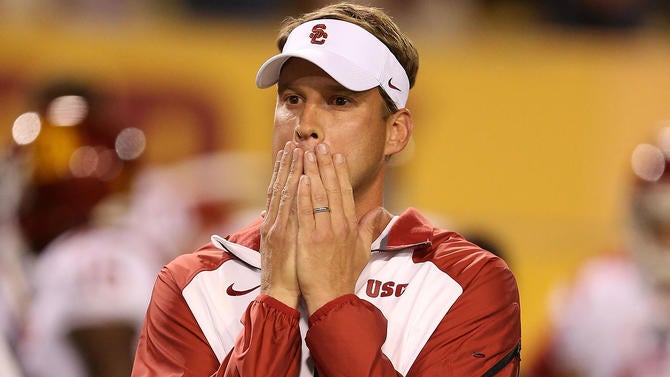
The risk that changed everything
There were no limitations when it came for the biggest strategic decision of Saban's career.
The 2013 season ended with a two-game losing streak, the first loss being the Kick Six game against Auburn. Saban made the decision to bring in Kiffin, who'd had months to stew after being fired at USC. Installation of the spread began.
"I remember him saying it: 'We're a Mercedes that's getting ready to drive off the edge of the cliff,'" Kiffin recalled. "'It looks good, it looks pretty, but it's not working anymore.'"
After that two-game losing streak, Alabama only lost four times in Kiffin's three seasons. The spread was installed in 2014 with former running back Blake Sims setting the school total offense record … at quarterback. Those seasons produced three straight SEC titles and three consecutive SEC Offensive Players of the Year at three different positions: Amari Cooper, Derrick Henry and Jalen Hurts.
Kiffin's reputation was in much need of a cleansing when he arrived in 2014. The son of defensive mastermind Monte Kiffin had acquired the label of having been born with a coaching silver spoon in his mouth. Al Davis got rid of him after 20 games with the Raiders. Kiffin then bailed on Tennessee after a season, creating a tsunami of backlash in Knoxville and around the SEC. A shot at USC ended with the epic firing on an airport tarmac once the Trojans arrived back from a 21-point loss at Arizona State in 2013.
Kiffin experienced all of this before age 39.
Saban saw Kiffin still on the rise, and at his essence, a master of play calling who could install the spread at Alabama. By the time Kiffin lined up with Sims in 2014, it had been almost a year since he'd been on a sideline.
"I couldn't get a job in the middle of the year," Kiffin said. "You take your kids to school. You try to stay away from the public eye because you feel like everyone is looking at you. 'Oh, there's the fired guy.'"
Alabama's first season under Kiffin, the offense piled up almost 6,800 total yards going from 33rd to 18th nationally in that category. More importantly, a program that had been the picture of stability had changed its offensive identity with a coordinator who was known as anything but stable.
"You gotta want to change, and [Saban] did," Kiffin said. "It's not like I came in there and said, 'You should change.' He said, 'I want to change.' It was his idea."
The three straight SEC titles yelled stability and transformation despite Kiffin's career arc having resembled that of a pro wrestler -- flamboyant and adaptable. He even left Alabama under odd circumstances, accepting the FAU job before the CFP National Championship with Sarkisian stepping up from analyst to offensive coordinator for the first time in a national title game.
Kiffin and Sark had brought a team to that game as members of the same staff for the third time in their careers. College football's Lennon and McCartney had done the same at USC in 2005 and 2006.
At age 46, now coaching at his third SEC school and 10th stop in a 24-year coaching career, Kiffin has transformed from a heel to something of a babyface at Ole Miss.
At a minimum, he is not as reviled anymore. And considering his Alabama accomplishments, Kiffin is evolving into something of a sage. Rebels quarterback Matt Corral led the SEC in passing during a season highlighted by a shootout loss to Kiffin's old boss.
If Kiffin can develop just a bit more defense, watch out. He's already recruited well at both FAU and Ole Miss where he's boosted interest and wins while lighting up the scoreboard and remaining his boisterous self, even if a bit toned down.
Kiffin relayed a conversation with defensive coordinator Kirby Smart following his first game at Alabama. The Tide beat West Virginia 33-23 that year by running 82 plays, gaining 538 yards and holding the ball for almost 38 minutes.
"I remember Kirby after the game saying, 'Thanks. We're not used to games like that.' I said, 'What do you mean, that's just normal.'"
Asking 'Why?'
Learning Saban's "whys" and taking them to their next stop is something every assistant cites as being of paramount importance after joining the program. But the "whys" these accomplished coaches ask themselves before going to Alabama are less publicized.
Why take a low-level job -- or at least take a step down -- even if it is to coach at Alabama?
The answers all come back to Saban. Groh had been a Power Five coordinator. Certainly, he could have done better than a GA job. Except he was out of work in February 2009, a time when most jobs are filled. That and Groh's destiny at that point had already been determined.
Virginia's former head coach, Al Groh, did not fire his son. The dismissal came from former Virginia AD Craig Littlepage, who oversaw Mike due to nepotism guidelines. Al had coached with Saban and Belichick on the same Browns staff in 1992. That started a lifelong personal and professional relationship that Al passed down to his son.
"Mike was hearing the same gospel all along the way," Al Groh said. "So when he went down to Alabama … all the things he learned from clearly the most successfully college head coach in history [were ingrained]."
Still, Mike Groh had to swallow hard and call Saban, just like anyone else, to determine if there were any openings.
"I don't know if he was thinking this way before the call, but he had the foresight and the vision [to think], 'This is a way for us to gain a competitive advantage within the rules,'" Mike said.
Groh was eventually paired with Napier. By the time Groh returned as receivers coach in 2011, he was tasked with helping rebuild the wideout room. Julio Jones had left in 2010, Cooper arrived in 2012, and the conga line of great Alabama receivers began.
"When I came back in 2011, the receiver corps there were no names that weren't recognizable unless you're an Alabama fan," Groh said. "We were kind of under strict orders to build this position up. I wouldn't want to say that to disrespect the guys that were there. We were able to get Amari, and it's taken off from there."
Napier was in a similar position. After being fired at Clemson, he stepped in as an analyst. Alabama won its second title in three years.
"I don't necessarily think I was hired as an analyst," Napier said. "I think the term was, 'I don't really think I have a job right now. Why don't you just come over here and spend the year with us?'"
Even then, it was clear to Napier that Saban was building something special.
"I'd been humbled," Napier said. "You get fired. You appreciate the opportunity to be there on the inside where I could observe and learn, soak it all in. When you have a lot less responsibility, it gives you an opportunity to spend a lot of time thinking and observing and really clarify what you believe in."
In 2013, Napier returned as Alabama WR coach and stayed four more years, winning the 2015 national championship. His impact at Bama is already assured. Shortly before he left to become offensive coordinator at Arizona State in 2017, Napier was able to land a 160-pound receiver from Amite City, Louisiana.
You might recall Devonta Smith, last year's Heisman winner.
"That staff [in 2016], if you put together those last five seasons, you would be like, 'Holy cow, these guys changed the trajectory of this dynasty tremendously,'" said current coach Oregon coach Mario Cristobal, whose last season at Alabama was also 2016.
Cristobal was never an Alabama analyst and doesn't like being classified as part of Nick Saban's Coaching Rehab. He left Alabama five years ago following a highly successful four-year run under Saban in which he helped recruit some of the program's biggest names. But he did join Bama in 2012 straight after leaving FIU in a firing that was highly criticized at the time.
Gradually, the former Miami offensive tackle brought the SEC line-of-scrimmage physicality to Oregon where Cristobal has since won back-to-back Pac-12 titles.
Nick Saban's Coaching Rehab takes on patients of all shapes and sizes, even those who do not see those opportunities in the same light. In the end, they all graduate clean on the other side.




